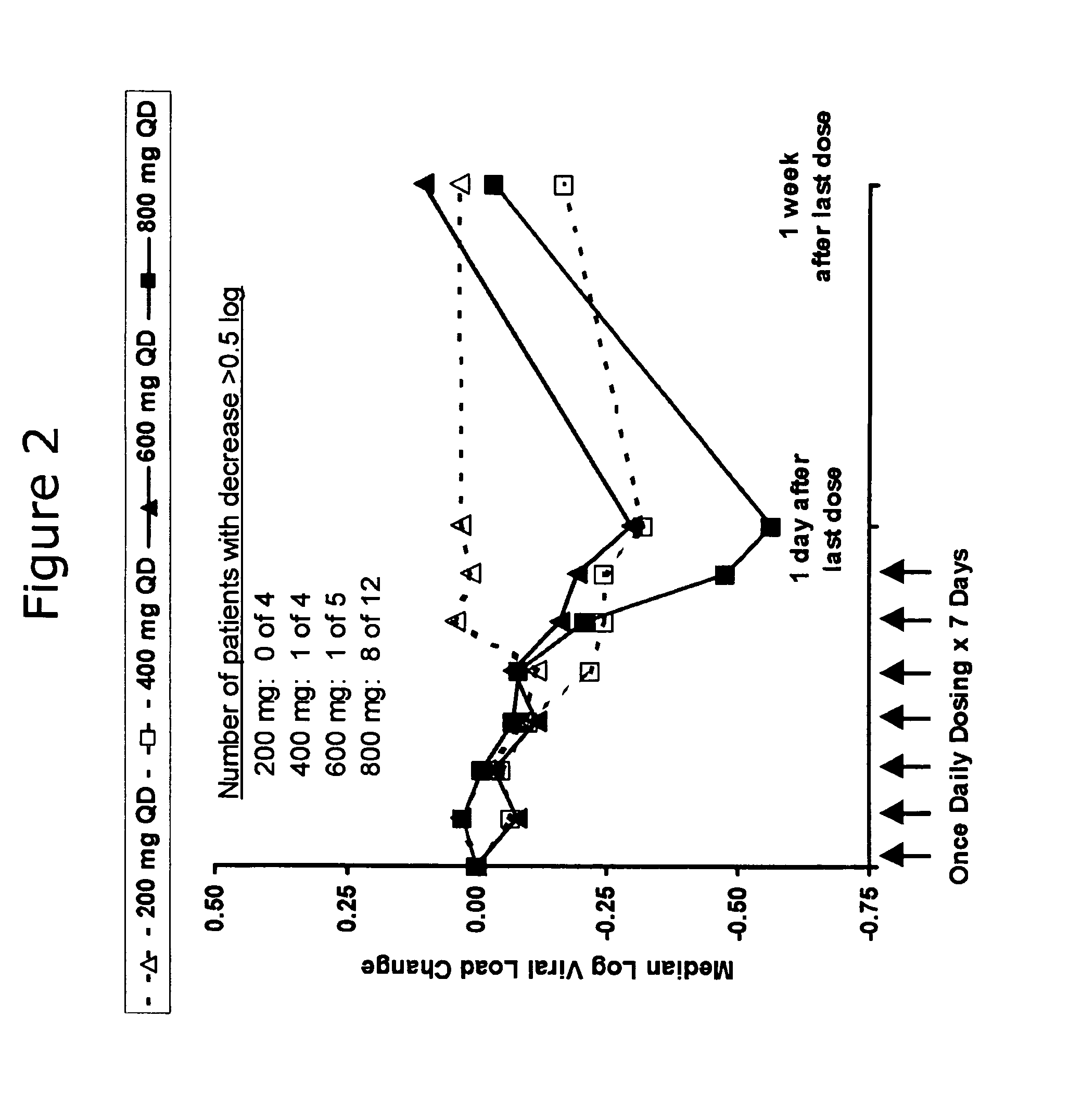Administration of TLR7 ligands and prodrugs thereof for treatment of infection by hepatitis C virus
a technology of hepatitis c virus and tlr7, which is applied in the direction of heterocyclic compound active ingredients, biocide, drug compositions, etc., can solve the problems of poor oral tolerability of immunomodulatory nucleosides, poor absorption, and difficulty in oral administration of many purine nucleoside analogs compared to intravenous routes
- Summary
- Abstract
- Description
- Claims
- Application Information
AI Technical Summary
Benefits of technology
Problems solved by technology
Method used
Image
Examples
example 1
7-Allyl-2-amino-9-β-D-ribofuranosyl-7,9-dihydro-purin-8-one (43)
[0293]
Step 1: Preparation of 7-Allyl-2-amino-9-(2′,3′,5′-tri-O-acetyl-β-D-ribofuranosyl)-7,9-dihydro-1H-purine-6,8-dione (40)
[0294]A heterogeneous mixture of 7-allyl-2-amino-9-β-D-ribofuranosyl-7,9-dihydro-1H-purine-6,8-dione 17 (1.00 g, 2.95 mmol, prepared according to Reitz et al., JMC, 37, 3561-3578 (1994)), DMAP (0.036 mg, 0.29 mmol) and NEt3 (2.05 mL, 14.74 mmol) was stirred in dry acetonitrile (25 mL). Acetic anhydride (0.862 mL, 9.13 mmol) was added slowly to the suspension and the reaction mixture was stirred at ambient temperature for 16 h. The solvent was removed under vacuum and the residue dissolved in dichloromethane (DCM). The organic phase was then washed with saturated aqueous sodium bicarbonate (NaHCO3), brine and thereafter dried with anhydrous magnesium sulfate (MgSO4). The solvent was concentrated under vacuum and dried at room temperature under high vacuum to give 1.33 g of 40 (97%) as a pale yellow...
example 2
7-Allyl-2-amino-6-ethoxy-9-β-D-ribofuranosyl-7,9-dihydro-purin-8-one (45)
[0298]
Step 1: Preparation of 7-Allyl-2-amino-6-ethoxy-9-(2′,3′,5′-tri-O-acetyl-β-D-ribofuranosyl)-7,9-dihydro-purin-8-one (44)
[0299]To a solution of 40 (0.30 g, 0.64 mmol) in dry THF (15 mL) was added polymer-supported triphenylphosphine (0.89 g, 1.93 mmol) and EtOH (0.11 mL, 1.93 mmol) at room temperature. To the stirring mixture was added diethyl azodicarboxylate (0.12 mL, 0.77 mmol) and stirring continued for 18 h. The spent polymer support was filtered off and the solvent removed under vacuum. The residue was then purified by flash chromatography using 10 to 50% gradient of ethyl acetate in hexanes. Removal of the solvent afforded 85 mg (26%) of the desired product 6 as a clear oil: 1H NMR (400 MHz, CDCl3) δ 6.07 (d, J=4.0 Hz, 1H), 6.06 (d, J=4.0 Hz, 1H), 6.01 (d, J=3.6 Hz, 1H), 5.96 (t, J=6.0 Hz, 1H), 5.87 (m, 1H), 5.14 (d, J=2.2 Hz, 1H), 5.15 (m, 1H), 4.80 (br s, 2H), 4.46 (m, 4H), 4.37 (q, J=7.2 Hz, 2H),...
example 3
5-Bromo-4-ethoxy-6-phenyl-pyrimidin-2-ylamine (37)
[0302]
Step 1: Preparation of 5-Bromo-4-ethoxy-6-phenyl-pyrimidin-2-ylamine (37)
[0303]In a manner similar to step 2 of Example 2 was prepared the title compound as a white solid from 2-amino-5-bromo-6-phenyl-3H-pyrimidin-4-one 35 (Wierenga, et al., JMC, 23, 239-240 (1980)) in 13% yield: 1H NMR (400 MHz, CDCl3) δ 7.61 (m, 2H0, 7.42 (m, 3H), 5.15 (br s, 2H), 4.23 (q, J=7.2 Hz, 2H), 1.44 (t, 6.8 Hz, 3H); MS (+)-ES [M]+ 294.1 [M+ 2]+296.0 m / z. Elemental analysis for C12H12BrN3O: calc'd: C, 49.00; H, 4.11; N, 14.29; found: C, 48.94; H, 4.18; N, 14.01.
PUM
| Property | Measurement | Unit |
|---|---|---|
| weight percent | aaaaa | aaaaa |
| weight percent | aaaaa | aaaaa |
| weight percent | aaaaa | aaaaa |
Abstract
Description
Claims
Application Information
 Login to View More
Login to View More - R&D
- Intellectual Property
- Life Sciences
- Materials
- Tech Scout
- Unparalleled Data Quality
- Higher Quality Content
- 60% Fewer Hallucinations
Browse by: Latest US Patents, China's latest patents, Technical Efficacy Thesaurus, Application Domain, Technology Topic, Popular Technical Reports.
© 2025 PatSnap. All rights reserved.Legal|Privacy policy|Modern Slavery Act Transparency Statement|Sitemap|About US| Contact US: help@patsnap.com



